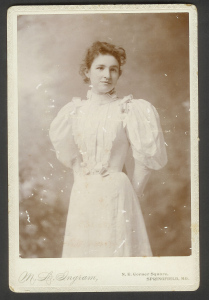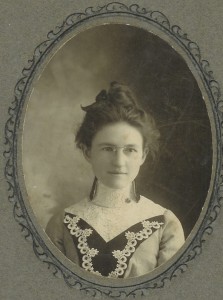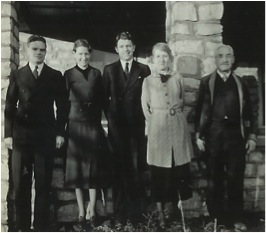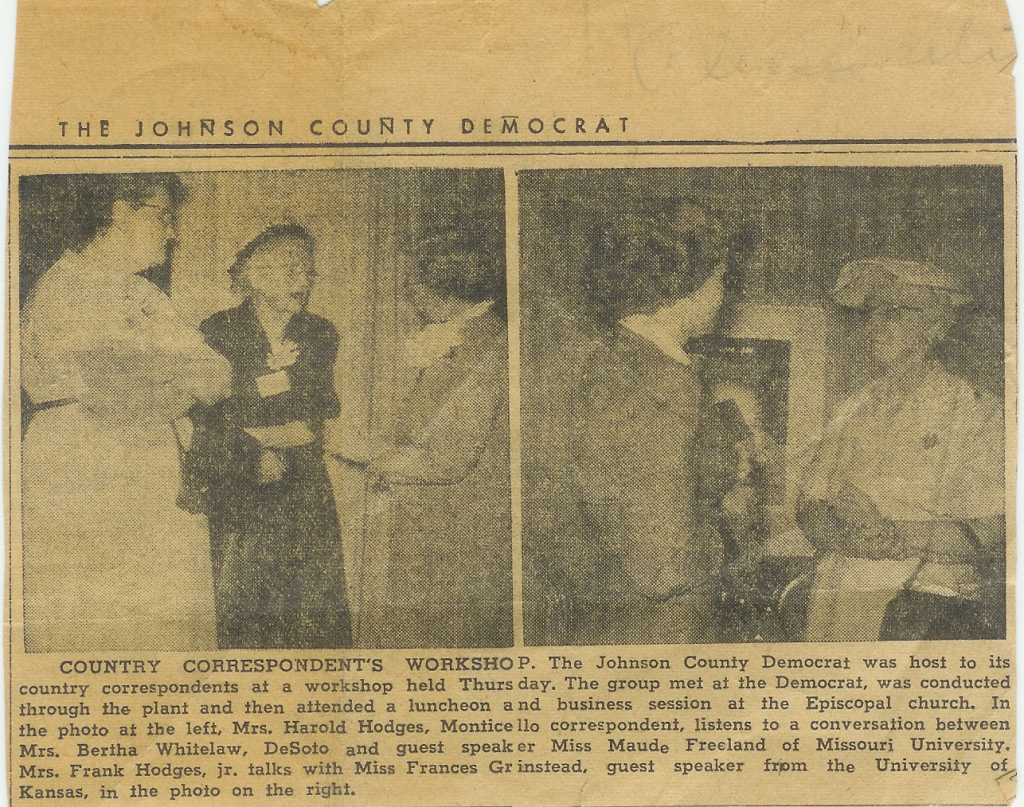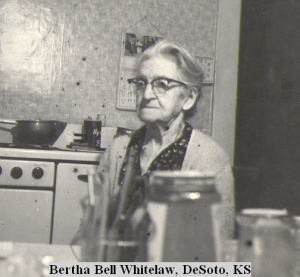My paternal grandmother, Bertha Bell Whitelaw, was in many ways ahead of her time. Born in 1872, she bridged the 19th century world of intensive home labor on small family farms and the subordinate position of women, with the emerging modern world of education for women and the possibility of a career. Her life story illustrates how she was able to meld these contradictory forces to achieve what she herself described as a “meaningful life.”
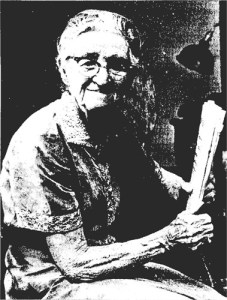
Bertha Bell Whitelaw, age 90, holding a newspaper for which she had recently written an article. (Goodell, 1962)
Bertha encompassed other disparate qualities. She lived in small farming towns in the Midwest, which generally lacked libraries or other cultural amenities. She was a full partner with her husband, John, in the hard daily work of farming. Church, community, and neighborly activities occupied much of her free time. Yet embedded as she was in the rural daily round, she also transcended it, by maintaining an active intellectual life. She could read both Greek and Latin, and had an enthusiastic interest in current affairs, both local and national. In her later years she defied gender and age stereotypes by maintaining independence and economic self-sufficiency through her own labor almost until her death at age 92.
How did she do it? Unfortunately she did not write very much about herself, and there is no indication that she thought she was in any way remarkable. Quite the opposite, in fact. But we have some of the letters she wrote weekly to her children over the course of twenty-five years, and we also have newspaper articles written about her in old age, as her community began to recognize that she was, as Pansy Penner, one of her neighbors, put it, “the most remarkable woman I ever knew.” (Penner, 1964.)
Pioneer Girl
Bertha was born on a homestead farm in Iowa soon after the Civil War. Her parents were of Scotch and Scotch-Irish background. Martha Gordon Bell, her mother, had grown up on a farm and taught in one-room rural schools before her marriage to Alexander Bell. He was an immigrant from Northern Ireland, a Civil War veteran, and a widower with two sons.
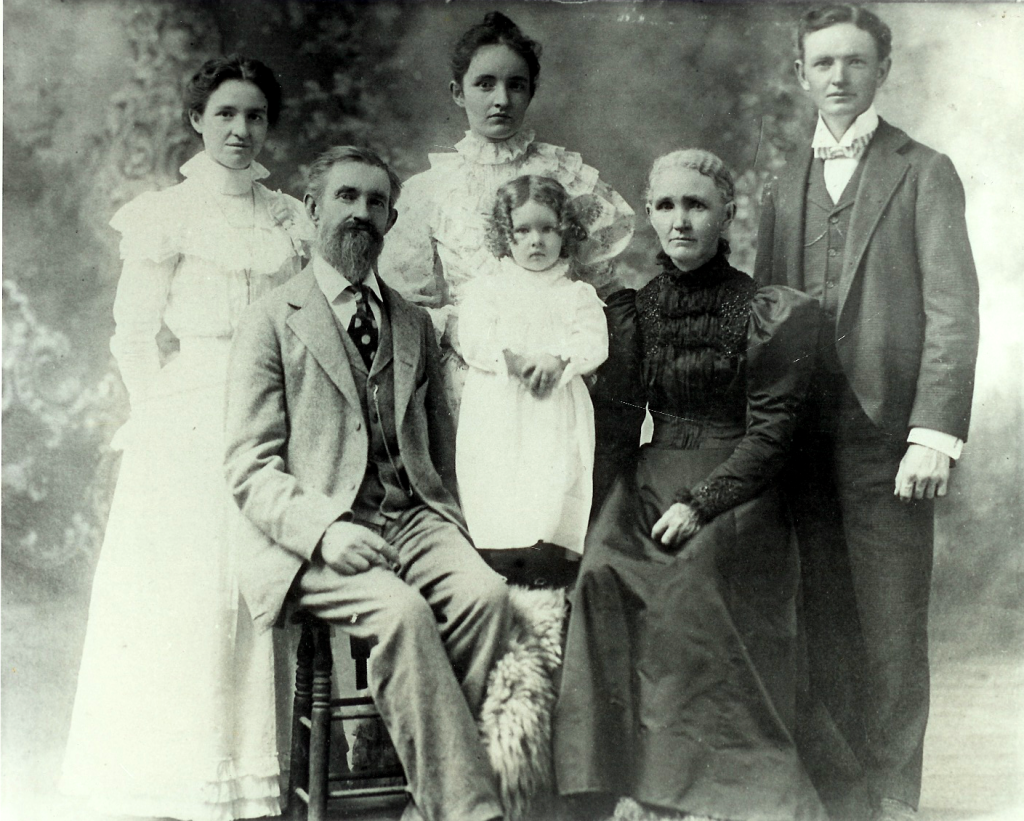
Front row: Alexander and Martha Bell with a grandchild; Back row, left to right: Bertha, her sister Eudora, and her brother Gordon. Springfield, Missouri, 1897
During the last months of her life, Bertha reminisced about her earliest years.
“Feb. 1, 1872 was my birthday. Bertha Elizabeth Bell, fourth child, 2nd daughter of Alexander Bell and 2nd daughter of Martha Ann Gordon Bell. Elizabeth for my grandmother Gordon – maiden name Elizabeth Ferguson – who knitted me a pair of white stockings with blue stripes. Born on a farm 3 ½ miles south of Earlham, Madison County, Iowa. Baptized at an early age in the Union United Presbyterian Church 7 miles distant.
Started to school at 5 years, walking two miles. Once lagged behind the older children and returned home. Repeated this and was returned to school by an irate mother. Later my sister and two brothers and I were taught by a neighbor young lady and a farm helper – and still later attended another school – also 2 miles away. Neighbors were distant and playmates few. Occasional visits to relatives, church and Sabbath school were our recreations. Reading aloud at home and a magic lantern pleased us. Also games.”
This memoir, brief though it is, sets key themes of Bertha’s life: challenging physical environments and a strong emphasis on education and religion.
Her parents, unusually for their time, were determined that Bertha and her sister would have a college education. After attending rural schools and a high school boarding academy, the girls were enrolled in Drury College, in Springfield, Missouri, where the family was now living. Bertha majored in Latin and classics, which prepared her to teach in institutes and academies, the equivalent of today’s high schools and community colleges. She graduated in 1895 as class valedictorian. Years later, Bertha recollected:
It wasn’t hard to get into college in those days because not many persons wanted to attend college. I had just grown up with the idea that I would attend college. I heard my mother talking to a young woman when I was quite young. They were talking about the woman’s having recently graduated from college. I liked the sound of that word “graduated” and decided I wanted to do it too.” (Enthusiasm for Life, 1962)
Educator
Bertha taught classics and Latin for eight years (1895-1903) in two different institutes in Missouri. There is a family story of Bertha as a teacher. One day she called on a large boy at the back of the class. He said he hadn’t prepared the lesson because this was his last day of school. Bertha responded, “All the more reason to study now.” This story highlights Bertha’s belief in the intrinsic value of learning.
While teaching at Kidder Institute in Kidder, Missouri, Bertha met John Whitelaw, who worked at the family hardware and implement business. She may have met him at the Congregational Church, which his family had helped to establish and where she was the Superintendent of the Sunday School. They got married in 1903, when she was thirty-one years old. As was the almost invariable custom of the time, she quit work to devote herself to the domestic sphere.
John and Bertha had four children, one of whom died shortly after birth. The family moved from Kidder to Lawrence, Kansas in 1910, where they began to farm. They grew wheat and other grains; kept ten horses which they used for plowing and other farm work, and had pigs and chickens. The farm also held a herd of dairy cows, which they milked themselves. Daily John or Bertha would drive a horse-drawn wagon with 20 or 30 gallons of milk to the nearby railroad station so they could be taken to the dairy in Kansas City.
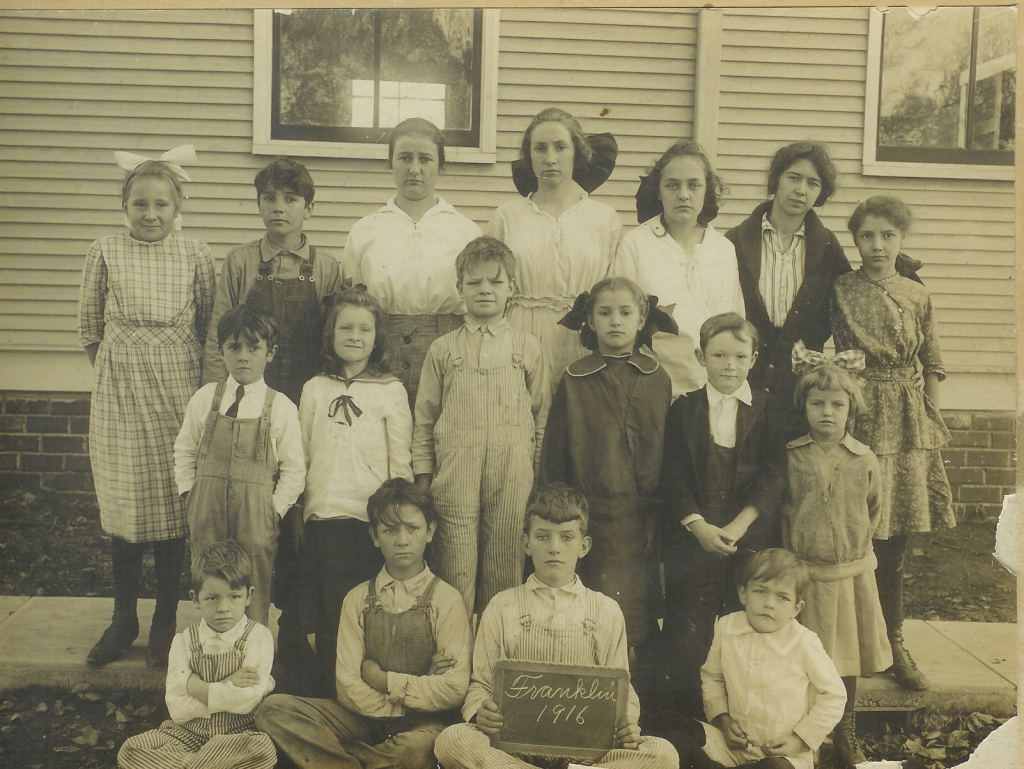
The Whitelaw children at the one-room Franklin School, Lawrence, Kansas, 1916. John, my father, is seated at the far left. His sister, Eleanor, is in the second row, second from left, and his brother, Neill, is next to her, third from left..
In 1919 the family moved from the farm to nearby DeSoto, Kansas, so that their oldest child, Neill, could live at home while attending high school there. (Many farm children did not attend high school, or had to board with a family in town.) They bought a small house in DeSoto, where they lived, and a farm about two miles distant. During the 1920s all of the Whitelaw children finished high school. With the strong encouragement and support of their mother, they each were valedictorian of their class. Although the family farm provided little income beyond supplying the basics of life for the family, John and especially Bertha were determined that their children would attend college. Her children credited her determination and encouragement for the fact that they all graduated from college and obtained master’s degrees. One son, Neill, obtained a Ph.D. in physics and became a professor.
Writer
In order to help finance college, Bertha, then in her fifties, started working part time as a reporter. She recounted:
“It was 1923. . . our children were off to college and, as any parent knows, that always means extra cash from the parents. We had lived near Lawrence, near Noria in Franklin community, before moving to DeSoto in 1919. We had read the Journal-World since 1910 and my first thought was to add to the family coffers by reporting.” (DeSoto Writer, date unknown.)
She was the local correspondent for the DeSoto News, the Johnson County Democrat, and the Lawrence Journal-World, and continued as a reporter for 39 years, only retiring when she was 90. During that time, she never missed sending in her weekly reports.
She reported on local happenings and events in people’s lives. A long time friend recounted: “It wasn’t just curiosity which prompted her favorite saying, “Know any news?” She was vitally interested in people and she converted that characteristic into newspaper correspondence . . .”
In an interview, she said that she considered that her specialty was writing about the doings of people who had been residents of De Soto and were still well-remembered but now lived elsewhere (Goodell, 1962). Just as her own children left town when grown, so did many others of that generation, so this was a rich field for her news-gathering.
She was able to get information for her reports easily because she was very active in the community. She was a member of the school board for many years, was a founding member of the Athenaeum Club, a local cultural organization, and a member of the De Soto Chapter of the Grange, an organization for farmers. She was a very dedicated member of the Methodist Church, where she taught Sunday School, and was a member of the women’s society and of a quilting society.
Reflections on Old Age
In her later years, Bertha continued to defy stereotypes about age and gender. She remained active both physically and mentally almost until her death at age 92. “She out quilts and out walks us all,” said a member of her quilting club (Kroh, 1958).
Bertha believed strongly in maintaining economic self-sufficiency even in old age, and refused to be dependent on her children in any way. She and her husband, John, had only their savings from selling the farm as income. Social Security became available to farmers in 1955, but the Whitelaws were not eligible for benefits because they had not had the opportunity to pay into this social insurance program. After she and her husband gave up farming, she earned money by taking in roomers, babysitting, selling eggs and chickens, and of course by continuing to write for newspapers. She and her husband maintained a vegetable garden and a cow for dairy products. She made most of her own clothes and bought very few products of any kind. She walked to town every day (about 8 blocks), refusing rides even in rain or snow.
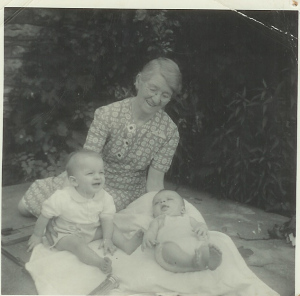
Bertha with grandsons John Whitelaw (on left) and Bill Whitford, 1940, during a family visit to De Soto, Kansas
She also remained very active in the community, keeping up her membership in all of her organizations. She taught her adult Sunday School class continuously for 44 years. She never stopped reading, particularly newspapers and the Bible. She said she enjoyed crossword puzzles and word games because they made her think. She also enjoyed stamp collecting and yard work. She maintained a frequent correspondence with her three children, all of whom lived in other states.
She described a typical week in a letter:
“A week ago Tuesday was our bazaar – we served two meals that day and cleared $400. Last Thursday was club – yesterday we met to make out the Athenaeum club books, today I went to Bible class and this forenoon I ironed, washed my hair and worked down some butter, of course besides the incidentals – but I feel well and not really tired.” (Whitelaw, 1951.)
She may have enjoyed old age as a particularly fulfilling time of life. On the occasion of her 81st birthday she wrote to her children:
“Maybe you think you dread being 81 – probably think you will never reach that age – neither did I and would have supposed life would hold nothing at that age but sitting around and waiting to die. However that is not the way I find it – as to health I feel as well as ever, perhaps, better than at many times, my enthusiasm is I believe up to par, and my interest and enjoyment of opportunities and pursuits still keen. Problems and worries are fewer and with an ever growing faith in God’s promises I can meet them better. So my testimony is that I am as happy or happier than at any time of life. Pardon me for devoting so much of this letter to talking about myself and taking from your time to read it all; but I thought that perhaps you might like to know something of how I feel when I am an old old woman. Take courage for yourselves and do not mind the added years – YOU need not really be OLD.” (Whitelaw, 1953)
References
DeSoto Writer Has Record on Her Job (1958). Lawrence Daily Journal-World, Lawrence, Kansas, date unknown but about 1958.
Enthusiasm for Life Keeps 90 year old DeSoto Resident Active, Youthful. (1962) The Daily News, Feb. 24, p. 5.
Goodell, Jane. (1962) Reporter, 90, Aids the J-W. Lawrence Daily Journal-World, Lawrence, Kansas. May 24, p. 12.
Kroh, Sarah. (1958) Quilting Bee Links the Decades. Kansas City Star, Kansas City, Kansas. About April 27, 1958 (date is blurred on the photocopy.)
Penner, Pansy (1964) Tribute. De Soto News, Johnson County, Kansas, September 3, Vol. 44, No. 47, p. 1.
Whitelaw, Bertha Bell (1951). Letter to Children and Grandchildren. Nov. 13, 1951. Reproduced in her Biography by Susan Love Whitelaw (see below).
Whitelaw, Bertha Bell (1953). Letter to Children and Grandchildren. February 6, 1953. Reproduced in her Biography by Susan Love Whitelaw (see below).
Whitelaw, Susan Love (2007). Bertha Bell Whitelaw: 1872-1964, A Documentary Biography with an Appendix of Family Documents. Chelsea, MI.
For More Information, click here for the blog entry on Bertha’s husband, John Whitelaw, Jr. Click here for a complete copy of Susan Whitelaw’s biography of Bertha Bell Whitelaw.
How You Are Related to Bertha Bell Whitelaw On your personal fan chart, Bertha Bell Whitelaw is either in the third ring (if you are her grandchild) or fourth ring (if you are her great-grandchild) out from your name in the center.

